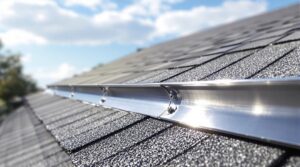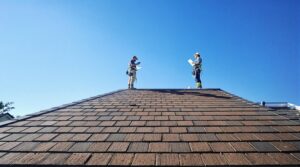Want to protect your home's foundation while keeping your wallet happy? Let's talk gutters! Think of gutters as your roof's personal bodyguards, directing rainwater away from your home's foundation with military precision.
Installing these water warriors isn't just about hanging channels – it's a carefully choreographed dance of measurements and planning. Your choice of materials can transform both function and curb appeal, from budget-friendly aluminum to show-stopping copper, with prices dancing between $3 to $40 per linear foot.
The secret sauce? It's all in the details. Imagine your gutter system as a well-orchestrated symphony: support brackets conducting every 36 inches, downspouts strategically positioned every 40 feet, and a subtle slope that makes water flow as smooth as silk. Most homeowners invest around $1,135 for a complete system, though larger homes might see costs climb to $14,160 for extensive coverage.
But here's the thing – while DIY might tempt you, professional installation isn't just about hammering up some metal channels. It's about creating a bulletproof defense system for your home, complete with proper safety measures and expert know-how that ensures your investment stands the test of time and Mother Nature's mood swings.
Key Takeaways
Is Your Roof Gutter Ready for an Upgrade? Your Complete Cost Guide
Ever wondered what it takes to keep those rainfall rivers flowing smoothly around your home? Let's dive into the world of gutter installations!
You're looking at a national average of $1,135 for professional installation, though your final bill could swing anywhere from $990 to $14,160, depending on your home's size and gutter choices. Think of it as investing in your home's raincoat!
Material Matters:
- Aluminum: Your budget-friendly warrior, lasting 25 years ($3-15 per foot)
- Copper: The luxury champion, serving generations at $15-40 per foot
The Science Behind the System:
Just like a well-choreographed dance, gutters need precise spacing – brackets every 36 inches and downspouts every 40 feet. Your installer will calculate the perfect slope, ensuring water flows like a gentle stream rather than a stubborn puddle.
Breaking Down the Bill:
The skilled hands doing the installation typically claim 40-60% of your investment. Don't forget the supporting actors: permits, old gutter removal, and those humble splash blocks keeping water away from your foundation.
Style Meets Function:
- K-Style: The modern home's best friend
- Half-Round: Adding classic charm to historical homes
- Box Style: The commercial property powerhouse
Remember, choosing the right gutter system is like picking the perfect outfit – it needs to look good AND do its job!
Why Proper Gutter Installation Matters
While many homeowners may view gutters as a simple home addition, proper gutter installation represents a vital component of structural integrity and water management for any residential property. The installation significance extends beyond basic water collection, as gutters serve as the primary defense against foundation damage, soil erosion, and structural deterioration.
Proper positioning of gutters guarantees effective water diversion away from the home's foundation, preventing costly issues such as basement flooding, foundation instability, and compromised structural integrity.
Professional installation addresses essential factors including correct sizing, appropriate slope calculations, and strategic placement of downspouts. These elements work together to protect siding, prevent wood rot, and maintain landscaping integrity.
Additionally, expertly installed gutters safeguard against mold growth and water stains, which can compromise both the aesthetic appeal and structural soundness of the property. The long-term effectiveness of a gutter system directly correlates to the precision of its initial installation.
Regular gutter cleaning maintenance is crucial before and after any major roofing work to ensure optimal system performance and longevity.
Types of Gutters and Materials Available
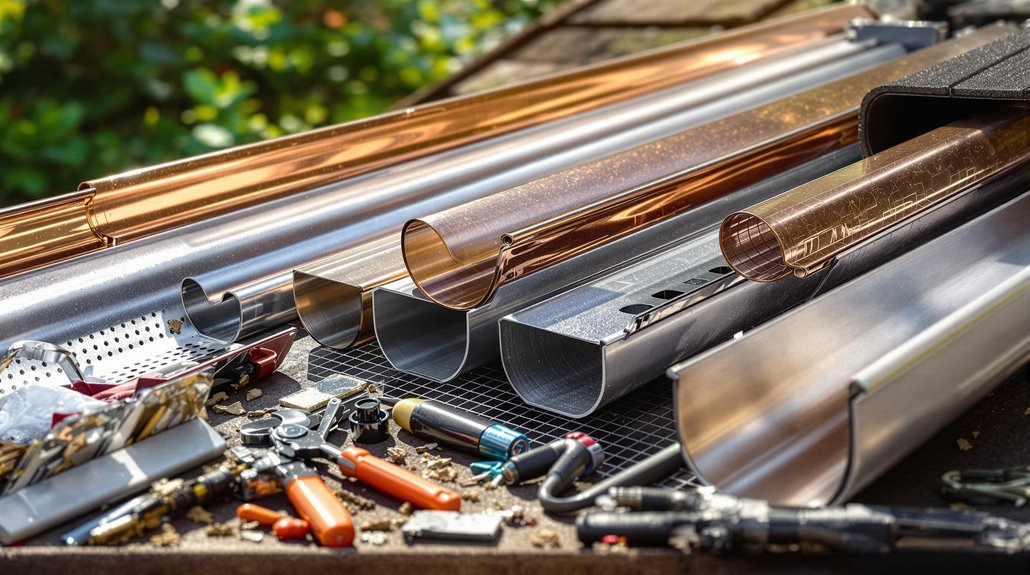
The selection of appropriate gutter materials and styles is critical for effective water management and long-term performance of a roofing system.
Common residential options range from cost-effective vinyl and aluminum to premium copper and steel, with installation costs varying from $4 to $25 per linear foot depending on material choice.
K-style gutters remain the most prevalent choice for modern homes, while half-round and box gutters offer specialized solutions for historical properties or areas with high rainfall.
Common Gutter Material Options
Selecting appropriate gutter materials represents a critical decision in any roof drainage system installation. When comparing Material Advantages, homeowners must evaluate factors including durability, cost, and climate suitability. A Durability Comparison reveals that while aluminum offers a cost-effective 25-year lifespan, copper systems can last several decades with minimal maintenance. Each material presents distinct characteristics for specific applications.
| Material | Durability | Cost Factor |
|---|---|---|
| Aluminum | 25 years | Moderate |
| Copper | 50+ years | Premium |
| Steel | 20 years | High |
| Vinyl | 10-15 years | Economic |
| Zinc | 50 years | Premium |
While aluminum remains popular for its lightweight properties and rust resistance, copper provides superior longevity and develops an attractive patina. Galvanized steel offers excellent durability against severe weather, and zinc combines exceptional lifespan with antifungal properties.
Cost Comparison By Material
Understanding material costs represents a primary factor in gutter system planning and budget allocation. Cost variations among different materials substantially influence the total project investment, with prices ranging from economical vinyl to premium copper options.
Vinyl gutters offer the most budget-friendly solution at $3-$7 per linear foot, while aluminum provides a mid-range option at $3-$15 per linear foot.
Steel gutters demonstrate increased material durability at $6.05-$28.80 per linear foot, though they require anti-rust maintenance. Copper represents the premium choice at $15-$40 per linear foot, offering superior longevity and aesthetic appeal.
For a typical 200-linear-foot installation, total costs span from $990 for basic vinyl systems to $14,160 for high-end copper configurations, with material selection directly impacting both initial investment and long-term maintenance requirements.
Supply chain disruptions can significantly impact material availability and pricing fluctuations across all gutter types.
Gutter Styles and Shapes
Modern gutter systems encompass diverse styles and shapes designed to accommodate varying architectural requirements and water management needs. The profile varieties available include K-style, half-round, fascia, box, and ogee designs, each offering distinct design aesthetics and functional benefits.
| Gutter Style | Key Features | Best Application |
|---|---|---|
| K-Style | Crown molding appearance, flat bottom | Modern homes |
| Half-Round | Traditional rounded profile | Historical buildings |
| Fascia | Integrated with fascia board | Contemporary designs |
| Box | Straight sides, flat bottom | Commercial structures |
| Ogee | Curved, decorative shape | Custom residences |
These profiles are available in both sectional and seamless configurations. Sectional systems offer easier replacement of damaged components, while seamless designs minimize potential leak points. Selection should prioritize water capacity, architectural compatibility, and installation requirements for ideal performance.
Calculating Your Gutter Installation Budget
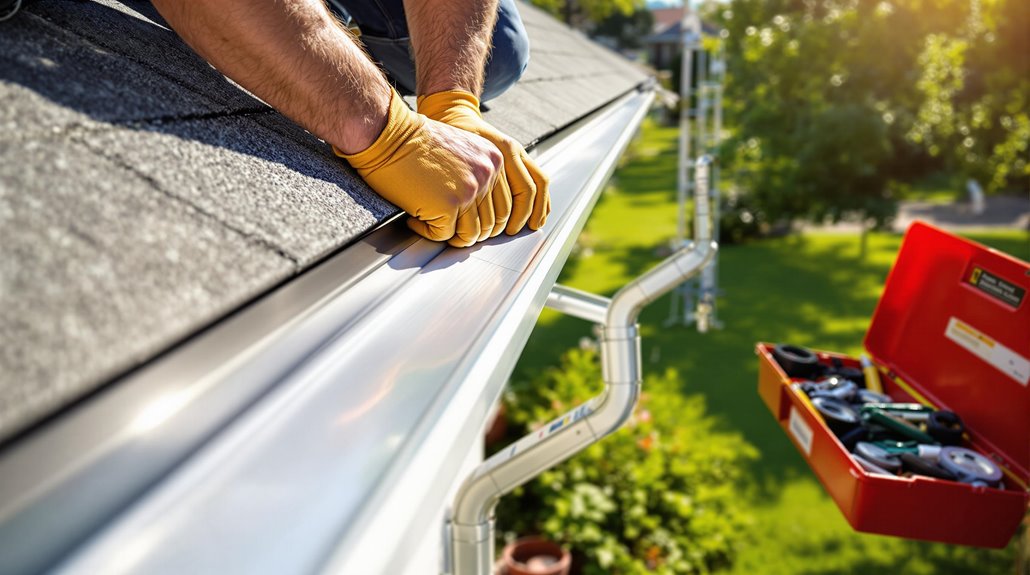
The total cost of gutter installation encompasses both material selection, ranging from economical vinyl to premium copper, and labor charges which typically constitute 40-60% of the project budget.
Installers must factor in additional expenses such as fasteners, downspout components, and specialized equipment for elevated installations.
Property owners can reduce costs by selecting standard K-style gutters, opting for aluminum materials, and scheduling installation during off-peak seasons while maintaining essential quality and safety standards.
Similar to roofing projects, professional installers require safety harness systems costing between $1,500-$2,500 for elevated work. In addition to safety harness systems, it’s crucial for professional installers to stay informed about best practices to ensure both safety and efficiency during projects. Incorporating roof ridge vent installation tips can significantly improve ventilation and prolong the life of the roofing system, making it essential knowledge for any contractor. By investing in proper training and the right equipment, installers can not only enhance their workmanship but also protect themselves and their clients.
Material and Labor Costs
Most homeowners can expect to invest between $1,000 to $2,000 for a complete gutter installation, with the national average cost hovering around $1,135. Material costs vary substantially, with vinyl gutters representing the most economical choice at $3-$7 per linear foot, while premium copper options range from $15-$40 per linear foot. Price fluctuations often stem from regional differences in material availability and labor rates.
Labor costs increase with installation complexity, building height, and additional safety requirements.
Certified contractors typically command higher rates but guarantee proper installation standards.
The selection of gutter type—seamless versus sectional—impacts both material and labor expenses. Custom configurations for unique roof designs or specialized gutter shapes require additional labor hours and expertise, contributing to elevated overall project costs. Working with contractors who have insurance claim experience can be advantageous when coordinating repairs covered by homeowner policies.
Hidden Installation Expenses
When planning a gutter installation project, homeowners must account for numerous hidden expenses beyond basic material and labor costs.
Understanding these unexpected charges helps prevent budget surprises and guarantees proper installation.
Key hidden costs include:
- Additional components: Downspouts ($5-20 per linear foot), screens ($8 each), gutter foam ($1.50 per linear foot), and splash blocks ($10 each)
- Removal and disposal fees: Old gutter removal ($1-2 per linear foot) and debris disposal ($150-350)
- Required permits and inspections: Minimum service fees ($140), permit processing ($20-30), and plan review costs
- Long-term considerations: Potential foundation repairs ($15,000+), basement flooding prevention, and gutter guard installation ($600-1,500)
These expenses substantially impact the total project cost and must be factored into the initial budget calculations.
Proper gutter maintenance can help extend your roof's lifespan, as missing shingles often indicate serious drainage issues requiring immediate attention.
Cost-Saving Installation Methods
Several cost-effective methods exist for calculating and optimizing gutter installation budgets while maintaining quality and safety standards. Homeowners can leverage seasonal pricing by scheduling installations during off-peak periods, potentially securing better rates from contractors. Strategic material selections, such as choosing aluminum over premium options like stainless steel, can reduce costs while ensuring durability.
Additional savings opportunities include bundling installation services and utilizing local cost calculators for accurate project estimates. Researching regional pricing averages helps establish realistic budgets, while obtaining multiple contractor quotes provides detailed cost breakdowns.
When evaluating materials, considering long-term maintenance requirements and durability factors alongside initial costs enables informed decision-making. These approaches help homeowners achieve cost-effective gutter installations without compromising system performance or structural integrity. Documenting the installation process with multiple angle photos before any work begins can protect homeowners if insurance claims become necessary.
Essential Tools and Equipment Needed
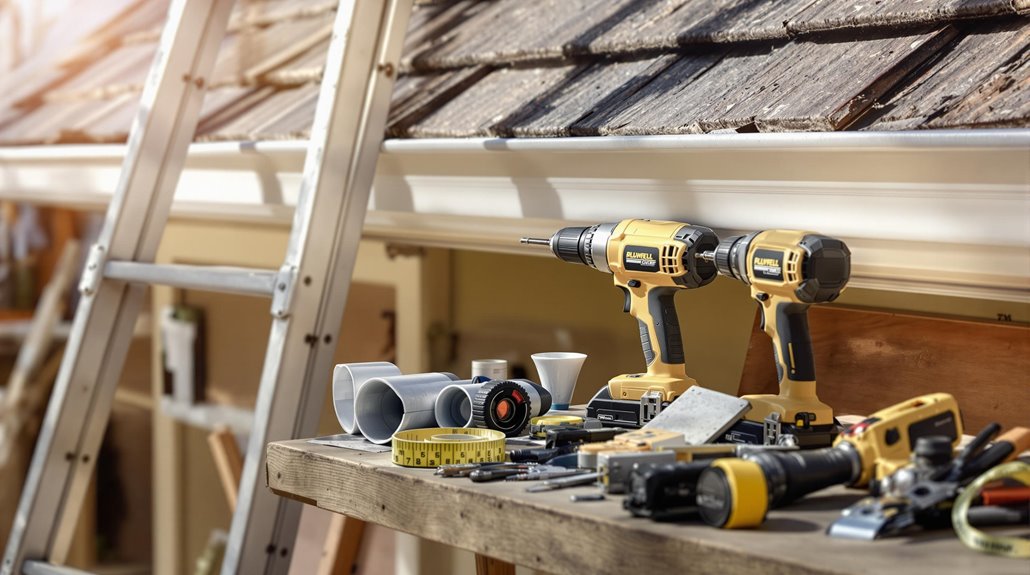
The successful installation of a roof gutter system requires a thorough set of tools and equipment to guarantee proper mounting, alignment, and water management.
Proper tool organization and equipment safety are essential for efficient project completion and worker protection.
The installation process demands both manual and power tools, along with specialized equipment designed specifically for gutter work. A complete setup includes:
- Basic hand tools such as ladders, tape measures, hacksaws, and levels for accurate measurements and positioning
- Power equipment including drills, impact drivers, and rivet guns with appropriate safety gear
- Essential gutter components like sections, downspouts, brackets, end caps, and sealants
- Specialized tools including downspout hole punches, seamers, and tin snips
Each tool serves a specific purpose in ensuring precise cuts, secure mounting, and proper water flow.
Having the right equipment readily available helps maintain workplace safety while enabling professional-quality installation results.
Similar to roof tear-off procedures, working systematically from top to bottom ensures efficient debris management and proper installation sequencing.
Step-by-Step Installation Process
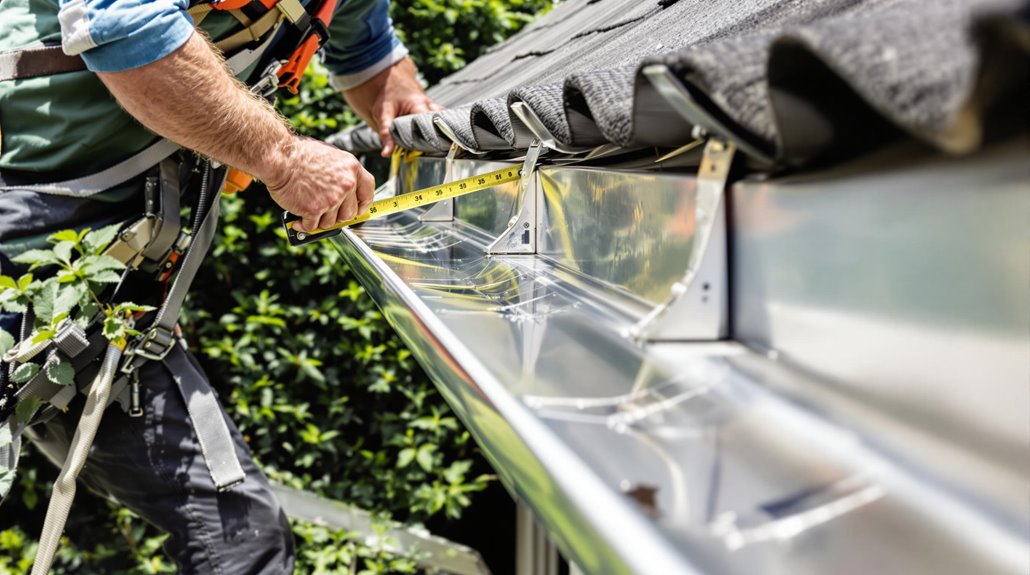
Installing a residential gutter system requires meticulous planning and precise execution across four main phases: pre-installation assessment, bracket mounting, gutter section assembly, and downspout integration.
The process begins with accurate roof measurements and downspout placement calculations. Bracket positioning follows strict 36-inch spacing requirements, with careful attention to maintaining proper slope for water drainage. Gutter alignment relies on precise chalk lines marking high and low points along the fascia board.
| Phase | Key Requirements | Safety Considerations | Quality Checks |
|---|---|---|---|
| Planning | Measure roof edges | Secure ladder setup | Verify measurements |
| Bracket Install | 36" max spacing | Use safety harness | Check slope angle |
| Gutter Assembly | Seal all joints | Wear safety gloves | Test connections |
| Downspout Setup | Every 40 feet | Secure wall mounts | Verify water flow |
Final installation includes securing gutter sections to brackets, installing end caps, and connecting downspouts with appropriate elbows and wall anchors, ensuring a complete and functional drainage system.
For areas with significant storm exposure, public adjusters can help evaluate and document any weather-related damage to existing gutter systems before replacement.
Safety Measures During Installation
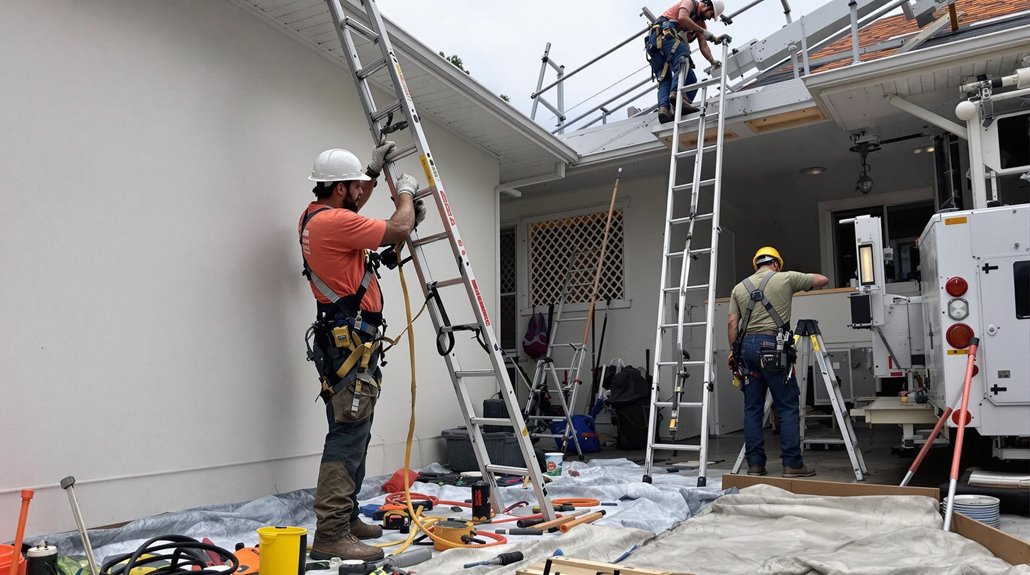
Proper safety protocols form the foundation of successful gutter installation projects, complementing the technical installation steps with thorough protective measures.
Similar to roofing insurance claims, documenting safety procedures with photos and videos provides important liability protection.
Fall prevention starts with proper Safety Equipment, including full-body harnesses with 5-point adjustment systems and guardrails for edge protection.
Workers must conduct thorough pre-installation inspections of all equipment, particularly ladders and hand tools.
Essential safety measures include:
- Positioning bucket trucks on level ground with proper outrigger deployment, maintaining the 500-pound weight limit
- Installing guardrail systems and safety-climbing gear before accessing elevated work areas
- Utilizing fall protection kits with lifelines and shock-absorbing lanyards
- Maintaining proper ventilation during soldering tasks and keeping fire extinguishers readily available
Environmental awareness remains vital, requiring surveys for insect nests and consideration of weather conditions.
Workers must wear appropriate personal protective equipment, including safety helmets and prescription lenses when necessary, while maintaining strict adherence to electrical safety protocols near power lines.
Common Installation Mistakes to Avoid
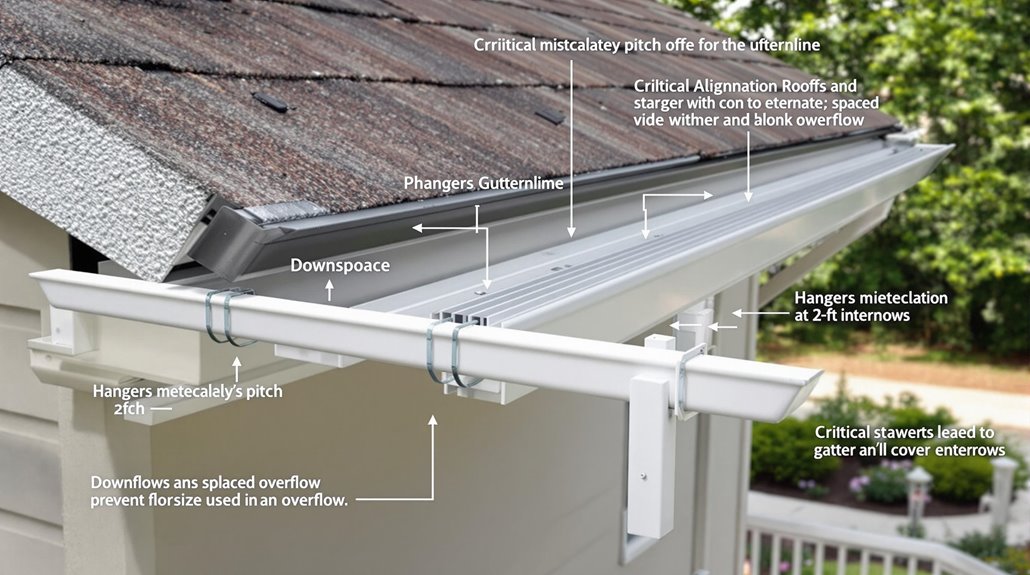
Despite following installation guidelines, contractors and DIY enthusiasts frequently encounter preventable mistakes during gutter installation that compromise system performance and longevity.
Critical mounting errors include incorrect pitch alignment, which impedes proper water flow, and violations of spacing guidelines when installing hangers beyond the recommended 2-3 feet intervals, leading to system sagging.
Improper placement of gutters relative to the roofline and insufficient downspout positioning every 30-40 feet can result in water overflow and foundation damage.
Material selection errors compound these issues, particularly when choosing undersized gutters or materials incompatible with local weather conditions. Technical oversights in measuring roof pitch and determining appropriate gutter dimensions further compromise installation integrity.
The consequences of these installation mistakes often manifest as structural damage to foundations, roof deterioration, and compromised landscaping. Additionally, improper fastening and excessive seam joints create vulnerabilities that lead to leaks, requiring costly repairs or complete system replacement.
Professional assessments can help prevent these issues, as thorough moisture detection tests during initial inspections reveal potential drainage problems before they escalate.
Maintenance Tips for Long-Lasting Gutters
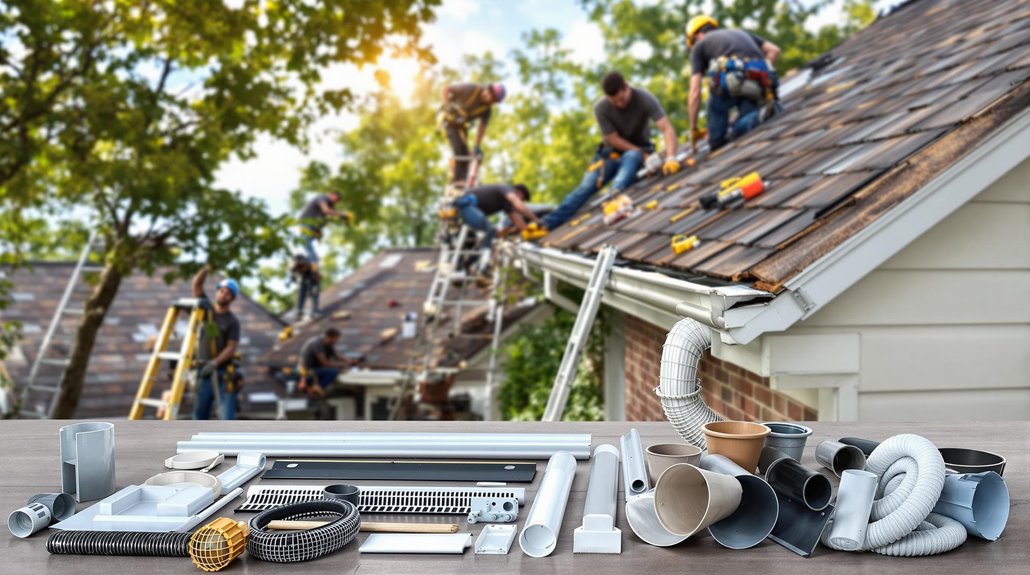
Longevity of gutter systems depends on implementing a complete maintenance schedule throughout the year.
A well-maintained gutter system prevents water damage to the home's foundation, walls, and landscaping.
Following proper cleaning frequency guidelines and conducting regular inspections guarantees peak performance.
Essential maintenance tasks include:
- Clean gutters bi-annually, specifically in spring and fall, removing leaves and debris using appropriate tools like gutter trowels
- Inspect for rust, corrosion, or structural issues during each cleaning session, addressing repairs promptly
- Test water flow by flushing with a hose after cleaning, ensuring proper drainage through downspouts
- Install protective measures such as gutter guards and downspout extensions to minimize maintenance requirements
For safety and efficiency, homeowners should consider professional services when dealing with complex repairs or installations.
Regular maintenance prevents costly damage and extends system lifespan.
When performing maintenance, avoid using leaf blowers or hanging items from gutters, as these actions can compromise structural integrity.
The Benefits Of Consulting A Public Adjuster
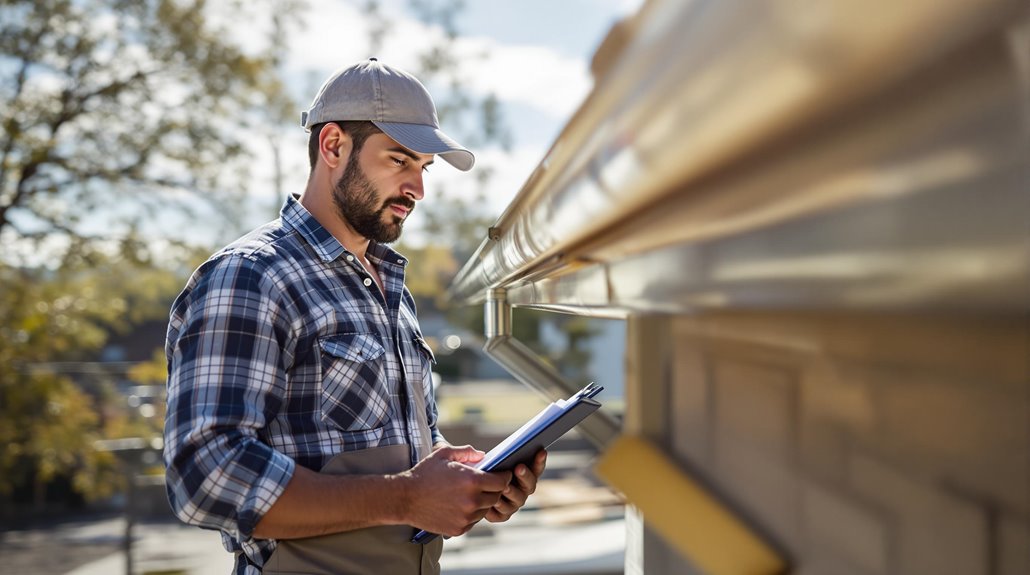
When dealing with gutter-related insurance claims, a licensed public adjuster provides expert assessment of damage patterns and thorough documentation that meets carrier requirements.
Their objective evaluation guarantees accurate identification of covered losses while maintaining compliance with policy provisions and local building codes.
Through their specialized knowledge of claims procedures and negotiation expertise, public adjusters typically secure higher settlement values while streamlining the entire claims process for property owners.
Expertise In Insurance Claims
Although gutter installations may appear straightforward, insurance claims related to water damage and structural issues can become complex legal matters requiring professional expertise.
Public adjusters offer specialized knowledge in policy interpretation and claims expertise, ensuring homeowners receive fair compensation for gutter-related damages.
Key aspects of professional insurance claim management include:
- Thorough assessment of policy coverage and exclusions specific to gutter and water damage claims
- Strategic documentation of damage patterns, contributing factors, and repair requirements
- Expert negotiation with insurance carriers to secure appropriate settlement values
- Compliance with filing deadlines and regulatory requirements to protect claim validity
This professional oversight helps homeowners navigate complex claim processes while maintaining focus on proper gutter installation and maintenance requirements.
Objective Damage Assessment
Professional damage assessment through a public adjuster provides property owners with a thorough and unbiased evaluation of gutter-related issues. During structural assessment, adjusters systematically document all visible damage, potential hidden issues, and contributing factors that may affect the gutter system's integrity.
| Assessment Component | Documentation Method |
|---|---|
| Visual Inspection | HD Photography/Video |
| Structural Analysis | Engineering Reports |
| Cost Evaluation | Multiple Contractor Bids |
The damage documentation process includes extensive reports detailing water damage patterns, material deterioration, and structural impacts. Public adjusters collect evidence through detailed photographs, maintenance records, and expert consultations to support insurance claims. This systematic approach guarantees accurate cost estimation and validates the scope of necessary repairs, ultimately strengthening the property owner's position during settlement negotiations.
Streamlined Claim Process
Efficiency in claims management stands as a primary advantage of consulting public adjusters for gutter-related insurance claims.
Their professional expertise substantially enhances claims acceleration while maintaining paperwork efficiency throughout the process. Public adjusters streamline documentation, manage communications, and guarantee compliance with policy requirements.
Key benefits of professional claim management include:
- Systematic organization of damage documentation, including precise measurements and photographic evidence
- Technical interpretation of policy language to maximize coverage potential
- Strategic negotiation with insurance carriers based on documented evidence
- Compliance monitoring to meet all deadlines and procedural requirements
This structured approach reduces administrative burden while allowing property owners to focus on restoration.
Public adjusters' thorough understanding of claims procedures helps prevent delays and establishes complete coverage for gutter-related damages.
Higher Claim Payouts & Settlements
Substantial evidence demonstrates that engaging public adjusters leads to higher insurance claim settlements for gutter-related damages. Statistical data from FAPIA reveals a significant increase in settlement maximization, with public adjuster-assisted claims averaging $22,266 compared to $18,659 for unassisted claims. Their expertise in damage assessment and negotiation guarantees payout optimization through thorough documentation and skilled advocacy.
| Settlement Factor | With Adjuster | Without Adjuster |
|---|---|---|
| Average Payout | $22,266 | $18,659 |
| Damage Assessment | Comprehensive | Limited |
| Negotiation Power | Professional | Basic |
Professional adjusters conduct thorough evaluations of gutter systems, identifying both obvious and subtle damage patterns that might affect long-term performance. Their understanding of insurance policies and settlement procedures guarantees maximum compensation for necessary repairs and replacements.
About The Public Claims Adjusters Network (PCAN)
The Public Claims Adjusters Network (PCAN) represents a nationwide coalition of licensed insurance claims professionals who specialize in policyholder advocacy and claims settlement optimization.
Members undergo rigorous adjuster certification processes and maintain state-specific licenses while adhering to strict ethical guidelines established by insurance departments.
PCAN membership benefits provide adjusters with:
- Advanced training in policy interpretation and damage assessment techniques
- Access to a collaborative network of experienced claims professionals
- Standardized documentation and reporting tools for enhanced transparency
- Resources for maintaining compliance with state-specific regulations
The organization serves as a central hub for public adjusters to share expertise, maintain professional standards, and enhance their ability to advocate effectively for policyholders.
Through PCAN's structured approach to claims management, members consistently achieve ideal settlement outcomes while ensuring full compliance with state insurance regulations and contractual requirements. This systematic methodology helps streamline the claims process while maximizing value for property owners.
Frequently Asked Questions
How Long Does a Professional Gutter Installation Typically Take to Complete?
Professional proficient installers complete typical gutter installation duration within 1-4 hours for average homes, while project timelines may extend to several days for larger or complex structures.
Can Gutters Be Installed in Winter or Extreme Weather Conditions?
Winter gutter installations are possible but face significant weather delays and temperature impacts. Professional installers must account for material brittleness, reduced daylight hours, and heightened safety risks during cold-weather operations.
Do I Need Permits From My City to Install New Gutters?
While most residential gutter installations don't require permits, homeowners should verify local permit regulations and zoning requirements. Some jurisdictions mandate approvals for specific drainage modifications or structural changes.
What's the Best Way to Join Two Sections of Gutter Together?
Professional gutter sealing requires creating lap joints with 3-4 inch overlaps, securing with rivets or screws, and applying waterproof sealant along both edges to prevent leaks and guarantee proper drainage.
Should Trees Near My House Affect My Choice of Gutter Style?
Nearby trees substantially influence gutter selection, requiring specific leaf protection features. Different species produce varied debris, necessitating tailored solutions with appropriate debris resistance capabilities to guarantee peak water management performance.
References
- https://www.spectraguttersystems.com/post/gutter-system-installation-tips-a-step-by-step-guide
- https://wernerroofing.com/blog/the-gutter-installation-process-guide/
- https://images.thdstatic.com/catalog/pdfImages/be/be7eb2c9-1655-4219-b93e-11d0eb4f5516.pdf
- https://www.homedepot.com/c/ah/how-to-install-and-replace-rain-gutters/9ba683603be9fa5395fab9019cce4fcd
- https://roofingkettering.com/gutter-installation/
- https://www.bryanexteriors.com/blog/understanding-how-gutters-work-and-why-they-are-important/
- https://www.proroofingnw.com/blog/2024/january/the-importance-of-proper-gutter-installation-for/
- https://stormmaster.com/gutters/proper-gutter-installation-tips-for-ensuring-a-long-lasting-system/
- https://homecraftgutterprotection.com/importance-of-installing-gutters-in-houses/
- https://www.townbuildingsystems.net/blog/gutter-statistics/


